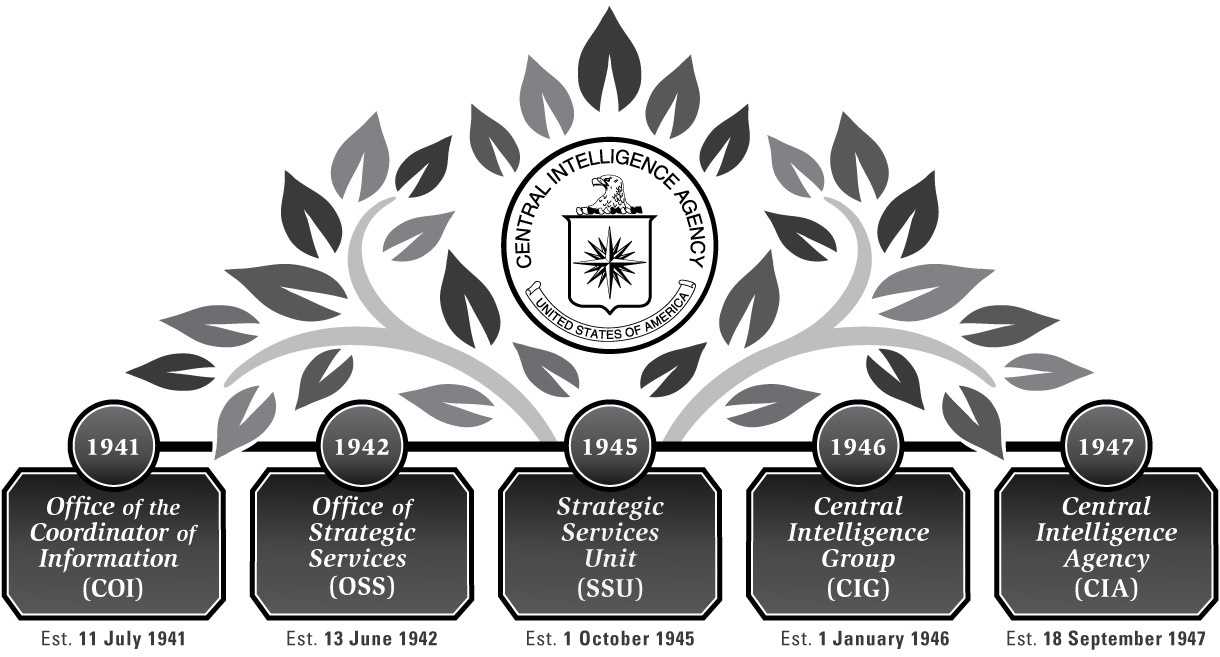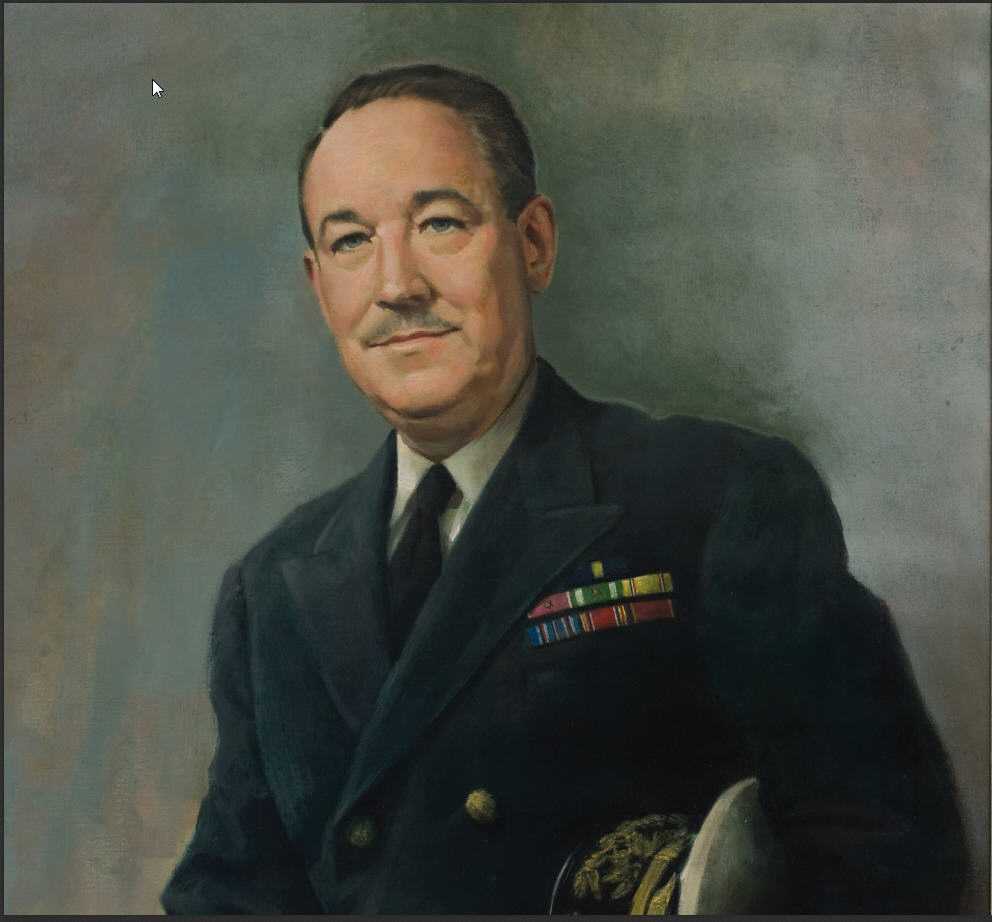Before
World War II
A Siloed Approach to Foreign Intelligence
The history of America’s foreign intelligence gathering reaches back to the Revolutionary war. But it wasn’t until World War II that our country’s foreign intelligence activities were coordinated government-wide.
Before the war, the Department of State, the Federal Bureau of Investigation (FBI), and the U.S. Armed Services were collecting intelligence with no direction or coordination.

1941
July 11
The Office of the Coordinator of Information
Frustrated by the piecemeal, stove-piped information he was receiving, President Franklin D. Roosevelt created the Office of the Coordinator of Information (COI). Led by World War I hero General William “Wild Bill” Donovan, COI’s main goal was to gather foreign intelligence related to the War.
As World War II progressed, Donovan and President Roosevelt reevaluated COI’s size, organization, and mission. At Donovan’s suggestion, President Roosevelt transformed COI into a new office with a title that reflected the importance of strategy in intelligence gathering and clandestine operations.

General William “Wild Bill” Donovan, the “father of American intelligence” and head of the Office of Strategic Services.
1942
June 13
The Office of Strategic Services
Often referred to as our Agency’s forerunner, the Office of Strategic Services (OSS) became the first centralized intelligence agency in American history.
Wild Bill Donovan led the women and men of OSS to collect and analyze strategic information and conduct unconventional and paramilitary operations.
Though the new office met some resistance from other U.S. agencies, OSS continued to grow its world-wide intelligence capabilities through military, diplomatic, and non-official cover. At its peak, OSS employed over 13,000 military personnel and civilians—35% of whom were women.
OSS existed for just over three years, but in this time it made a lasting contribution to our country, the world, and the future of American intelligence.

1945
October 1
The Strategic Services Unit
At the end of World War II, President Harry S. Truman abolished OSS along with many other war agencies. This left the Nation without a non-departmental, strategically oriented intelligence service.
On President Truman’s order, branches of OSS merged into a new office, the Strategic Services Unit (SSU). SSU took a temporary role filling former OSS posts across the globe until the United States could put a more permanent solution into place.
1946
January 22
The Central Intelligence Group
Early in the new year, Administration officials decided to move SSU’s duties and responsibilities to the newly created Central Intelligence Group (CIG). Unlike previous organizations of its kind, CIG was granted the authority to conduct independent research and analysis. This meant CIG could move beyond simply coordinating intelligence to producing intelligence.
President Truman chose Rear Admiral Sidney Souers, the deputy chief of Naval Intelligence at the end of World War II, to lead the CIG, making Souers the first person to hold the title of Director of Central Intelligence (DCI).
Within months of its creation, CIG became the nation’s primary agency for strategic warning and management of clandestine activities abroad. However, it was constrained by the Department of State and the armed services. President Truman soon recognized the need for a new, fully-functional post-war intelligence organization. So, in 1947 he signed the National Security Act, establishing the Central Intelligence Agency (CIA).

Rear Admiral Sidney Souers, head of CIG and the first person to officially hold the title Director of Central Intelligence.
1947
September 18
The Central Intelligence Agency
The National Security Act of 1947 established CIA as an independent, civilian intelligence agency within the executive branch. The Act charged CIA with coordinating the Nation’s intelligence activities and, among other duties, collecting, evaluating, and disseminating intelligence affecting national security.
The Act also created a Director of Central Intelligence, or DCI, to lead both CIA and the U.S. Intelligence Community. The DCI also served as the president’s main adviser on all intelligence matters. President Truman appointed former CIG Deputy Director, Roscoe H. Hillenkoetter, to be the first to lead the new Agency. One third of the CIA’s personnel were OSS veterans.
Two years later, President Truman signed the Central Intelligence Agency Act. This legislation allowed CIA to secretly fund intelligence operations and develop personnel procedures outside standard U.S. government practices.
By 1953, the Agency was an established element of the U.S. government. Its contributions in the areas of political action and paramilitary warfare were recognized and respected. CIA had grown six times in these six years, and set up three of the five directorates we have today.
As the Agency continued to grow, employees moved from offices in Washington, DC, to a new headquarters in Langley, Virginia. The Original Headquarters Building was the first home designed specifically for Agency officers. Today, CIA Headquarters still serves as an iconic symbol of our Agency and our mission.

Roscoe Hillenkoetter, the first Director of the newly created Central Intelligence Agency.
2004
December 17
The Intelligence Community Restructures
The role of the DCI changed in 2004, when President George W. Bush signed the Intelligence Reform and Terrorism Prevention Act. This new act restructured the Intelligence Community and created the Director of National Intelligence (DNI). DNI oversees the 17 intelligence agencies, including CIA, while serving as the president’s principal intelligence adviser. The Director of the CIA continues to oversee the CIA’s intelligence collection, analysis, and covert action to advance U.S. national security.
In 2015, DCIA John Brennan ordered the modernization of the Agency into “mission centers” to improve integration and cooperation among the five directorates to better address the most pressing intelligence concerns facing our nation.
Present
CIA Continues to Adapt and Lead
Our history has shaped us into who we are today. As the world shifts around us, we continue to adapt and lead in an ever-changing global landscape. With the same spirit and dedication of those who came before us, our world-class workforce is prepared to accomplish what others cannot accomplish and go where others cannot go.
Every U.S. President since Truman has relied on CIA to deliver intelligence in ways no other organization can. Every day we rely on our workforce to carry out the very same mission that we started with: collect, analyze, evaluate, and disseminate intelligence to the president and U.S. policymakers.
We are the Nation’s eyes, ears, and sometimes, its hidden hand. Reflecting on our role in American history, we are proud to serve and keep our country safe.
